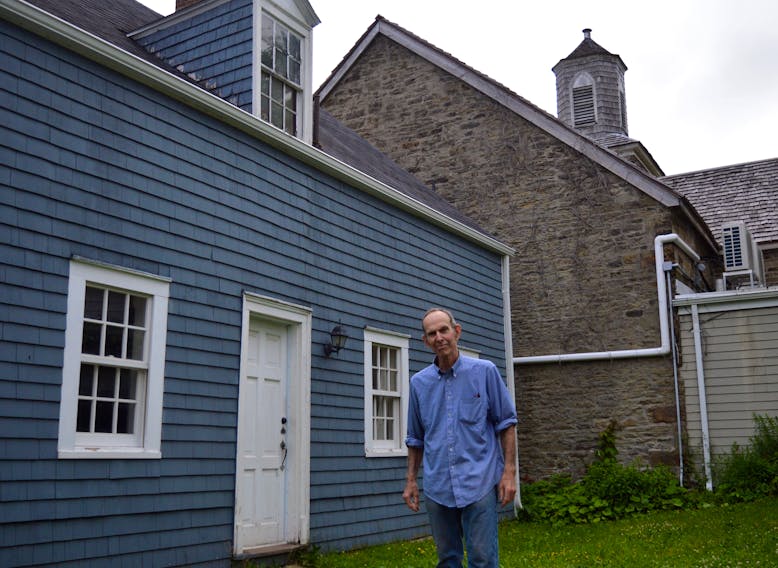SYDNEY, N.S. — If the walls of Sydney’s historic O’Brien House could talk what a tale they might tell.
The 18th-century house, one of Cape Breton’s oldest European-built structures, is now up for sale. Along with the 235-year-old house, the new owners of the harbour-facing Esplanade property will get an intimate opportunity to learn more about the structure’s varied and mysterious past.
Present owner Jim MacDonald purchased it in the early 1980s. Now 72 years old, MacDonald says it’s time to divest himself of the house that has intrigued him for almost four decades.
“There is amazing history right here — the architecture is very interesting and gives a glimpse into what things were like at that time,” said MacDonald, who has been busy cleaning and tidying up the registered provincial heritage property.
“But the history of what happened in the building is fascinating — over the years the house was used for everything from an inn, a tavern, a brothel, a church rectory, a store and a pharmacy.”

RENTED BY STUDENTS
Most recently, the house was rented by a number of Cape Breton University students from India. Prior to that, MacDonald ran it as a four-star vacation home and advertised the four-bedroom building with the phrase “have a 1785 inn all to yourselves!” Even Cape Breton University political science professor and Cape Breton Post columnist Tom Urbaniak lived there for a spell.
The structure is as old as Sydney itself, which was established by Col. Joseph Frederick DesBarres in 1785. The new community sprang up around the well-known and utilized inlet now called Sydney harbour. Many of the new arrivals were United Empire Loyalists who fled the United States following the Revolutionary War.
MacDonald said it’s his understanding that the house at 89 Esplanade was brought to Sydney by ship from Connecticut.
“There were no sawmills here when they first arrived so they brought some buildings with them,” he sai, of the structure that sits just across the road from the Joan Harriss Cruise Pavilion and dock.

ONCE A BROTHEL
Once re-erected, it is believed the house was used first as a tavern and inn, and then as a brothel.
“I heard that John O’Brien, the fellow that brought the house here, might have been ran out of town for having a brothel,” offered MacDonald, who added that he had heard that O’Brien was the leader of the local Masonic Lodge, which held its clandestine meeting within the walls of the waterfront edifice.
The house would also apparently be used as a meeting place for the privileged few who were appointed as the first officials of the Colony of Cape Breton, which would later be merged into Nova Scotia in 1820 by the British government.
The structure proved to have longevity as it has long outlasted other period homes in Sydney’s historic north end. Its nearest neighbour is St. Patrick’s Church. The impressive stone building dates back to 1828 and is the oldest-standing Catholic church in eastern Nova Scotia.
The O’Brien House is located in Sydney’s North End Conservation District and is just a short walk to St. George’s Anglican Church, which is another stone Gothic Revival-style church, and the nearby Cossitt House, which dates back to 1787.

AGE APPARENT
Inside, the house shows its age. Upon entering through the heavy front door, visitors are immediately faced with a steap set of stairs heading to the spacious upper levels. Beside the staircase is an old grandfather clock. To the right is a wide-open room that once served as the tavern. To the left is a smaller living room with a fireplace. The back left is where the basic kitchen is located.
The second-storey has four bedrooms and a bathroom. Three of the windows afford views of the nearby inlet once known as Landing Cove. While the furniture is not exactly 18th-century, MacDonald has found enough older items to maintain the building’s “old” theme.
There’s also an attic. It’s actually more than an attic as it was once divided into three rooms. Indeed, the entire third-floor with its steep roof once was the living quarters for the servants.
And then there is the downstairs. The basement. It’s dankness is immediate. It’s like climbing back into time. There’s a dirt floor in one corner where coal was once piled. Not far away, there is an abundance of stones that MacDonald believes came from the Fortress of Louisbourg, which was sacked and demolished after the British claimed the impressive French fortification for the second time in the mid-1700s.

MIXED EMOTIONS
Ironically, just a few steps from the old stones is some electronic gadgetry that controls the first storey’s in floor heating. A modern touch for a very old building.
For his part, MacDonald said he has mixed emotions about selling the property.
“I like old and this is old — but I’m getting older and it’s time to move on,” he explained.
“And I would really want this place to go to someone who also likes old and who will respect its history.”
He’s asking $279,000 for the property, which he believes would work well as a restaurant, café, artisan’s shop, or store.










